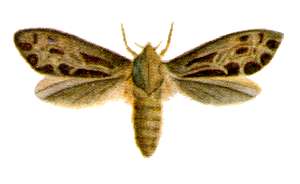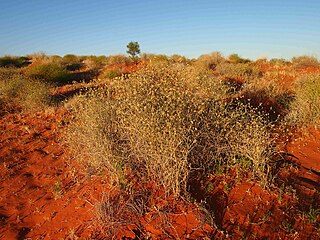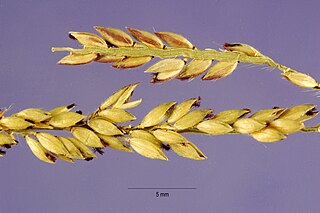
Oncopera is a genus of moths of the family Hepialidae. There are 12 described species, all endemic to Australia. The larvae usually feed on grasses, although that of O. intricata has been recorded on strawberry.

Zygochloa is a genus of desert plants in the grass family known only from Australia. The only known species is Zygochloa paradoxa, commonly known as sandhill canegrass. It occurs in extremely arid areas such as the Simpson Desert.

Bothriochloa is a common and widespread genus of plants in the grass family native to many countries on all inhabited continents and many islands. They are often called beardgrass, bluegrass or bluestem. Some species are invasive in areas where they have been introduced.

Eriochloa is a widespread genus of plants in the grass family, commonly called cupgrass. They are found across much of Africa, Asia, Australia, and the Americas, plus a few places in European Russia.

Gahnia is a genus of sedges native to China, Southeast Asia, New Guinea, Australia, New Zealand and a number of Pacific Islands. The common name is due to the toothed margins. It often forms tussocks.
Pheidochloa is a genus of Australian and Papuasian plants in the grass family.
Plinthanthesis is a genus of Australian plants in the grass family.

Pseudoraphis is a genus of Asian and Australian plants in the grass family, commonly known as mudgrasses.
Ancistragrostis is a genus of Australian and New Guinean plants in the family Poaceae.

Cleistochloa is a genus of bunchgrasses in the family Poaceae, found in southwestern in Oceania.
Australopyrum is a genus of plants in the grass family, native to Australia, New Zealand, and New Guinea.

Schizachyrium is a widespread genus of plants in the grass family. The name is derived from the Ancient Greek words σχίζειν, meaning "to split," and ἄχυρον, meaning "chaff." It refers to either the glume or the toothed lemmas.

Dichanthium, known commonly as bluestem or bluegrass, is a genus of African, Asian, and Australian plants in the grass family.

Paraneurachne is a genus of Australian plants in the grass family. The only known species is Paraneurachne muelleri native to Western Australia, South Australia, Northern Territory, and Queensland.

Ectrosia is a genus of Asian, Australian, and Pacific Island plants in the grass family.

Neurachne, commonly called mulga grass, is a genus of Australian plants in the grass family.
Hookerochloa is a genus of Australian plants in the grass family.
- Hookerochloa eriopoda(Vickery) S.W.L.Jacobs - Queensland, New South Wales, Victoria
- Hookerochloa hookeriana(F.Muell. ex Hook.f.) E.B.Alexeev - New South Wales, Victoria, Tasmania

Tragus australianus, common names Burr grass, Small burrgrass, and Tickgrass, is a summer ephemeral grass, first described by Stanley Thatcher Blake in 1941. It flowers in response to rain. Its native range is mainland Australia, where it is found in arid and semi-arid areas.
Ernest Norman McKie, was an Australian clergyman who was also an amateur botanist with a detailed knowledge of the eucalypts and grasses of the New England district of New South Wales. He was born in Barraba in 1882, entered St Andrew's College, University of Sydney where he graduated in 1906, then completed his theological studies before being posted to Manilla in 1908, then Bendemeer, later Guyra in 1912.

Ancistrachne uncinulata, the hooked-hairy panic grass, is a grass, and was first described in 1810 as Panicum uncinulatum by Robert Brown, and then in 1941, was assigned to the genus, Ancistrachne, by Stanley Blake. The name accepted by Australian authorities is Ancistrachne uncinulata, but the name accepted by Kew is Cleistochloa uncinulata.














